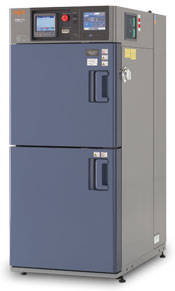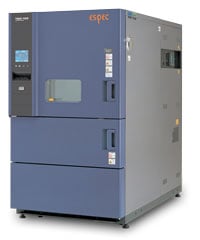Defining 'thermal shock'
 “Thermal shock” is deceivingly simple test name—it denotes a sudden change in temperature. It’s the definition of “sudden” that makes it a more difficult term.
“Thermal shock” is deceivingly simple test name—it denotes a sudden change in temperature. It’s the definition of “sudden” that makes it a more difficult term.
Many people assume that an immediate switch to an oven or freezer is enough to create thermal shock. But if the sample is massive, or the oven has slow airflow, it may take a while for the temperature of the sample to stabilize with its surroundings.
Most thermal shock testing is concerned with the sudden change of the product temperature. For this type of application, high airflow makes the sample give up its heat faster. “Prechilling” the air below the desired temperature speeds-up the product temperature change. If you want the sample to get to -40°C as fast as possible, get the chamber to -60°C before you put the sample in.
Fast product change is valuable for forcing failure, but is not necessarily representative of the normal use of the sample. Integrated Circuits (ICs) are commonly tested by Mil-Std 883 1010.7, which requires a full recovery of the worst-case product within ten minutes. This means embedding a thermocouple sensor inside a sample and monitoring it.
By using liquid instead of air, the heat transfer becomes even faster. This also becomes a progressively more expensive choice. The liquids that need to be used are costly and can evaporate quickly if precautions are not made. The capacity is not very impressive, so only a few samples can be tested at a time.
Related Products from ESPEC
 ESPEC North America, Inc. (Corporate office)
ESPEC North America, Inc. (Corporate office)
 “
“